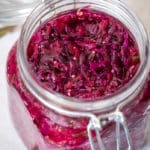Description
Fermentation is one of the oldest and safest methods of preserving food known to humanity. While it might seem intimidating at first, it’s surprisingly simple to get started. This red cabbage sauerkraut is a great way to explore the basics of fermentation and create a gut-friendly food you can enjoy daily—as a condiment, side dish, or a flavorful boost to any meal.
Ingredients
Jar: 1 quart / 36 oz / 1 L glass jar with lid
About 2 lbs (800–900g) organic vegetables — red cabbage (white cabbage works too, or a mix), plus one large carrot
12.5g non-iodized salt (about 1.5% of the total vegetable weight)
Optional spices: ¼ teaspoon each of coriander seeds, fennel seeds, and mustard seeds
Instructions
- Thoroughly wash the jar, lid, and your working surface. Rinse and pat dry the vegetables.
- Finely shred the cabbage (one medium or two halves) and place it in a large mixing bowl. Set aside a couple of whole outer cabbage leaves to use later. Grate one large carrot and add it to the bowl.
- Sprinkle the salt (and optional spices) over the vegetables, then massage everything with clean hands for 5–10 minutes, until the vegetables soften, release their juices, and reduce in volume.
- Transfer the mixture and the liquid into your jar, pressing down firmly to eliminate air pockets and make sure the vegetables are fully submerged in their own brine. Fold and place the reserved whole cabbage leaves on top, pressing down again. Secure the lid loosely (without the silicone seal) to allow gases to escape during fermentation.
- Place the jar in a shallow bowl to catch any overflow, and leave it at room temperature, away from direct sunlight. Open the lid once a day and press down gently with a clean spoon to keep everything submerged.
- Fermentation usually takes 4–7 days, depending on the temperature of your kitchen. It could even be faster is it’s very hot. Start tasting after day 4. Once the kraut reaches your preferred level of sourness, remove the top leaves, seal the jar fully, and refrigerate.
- Enjoy a small amount daily as a gut-friendly condiment or side dish.

